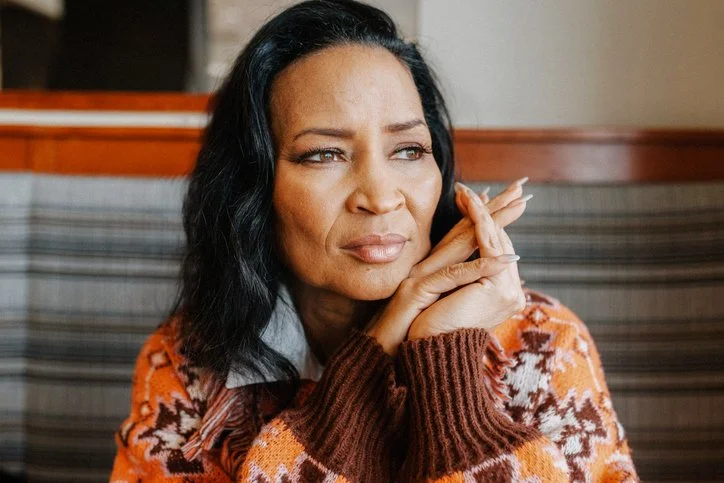Healing Isn't Mystical: It's What Happens When the Body Finally Feels Safe Enough to Stay
Why Most Spiritual Coaching Misses the Point—and How Real Healing Happens When We Reunite the Body and Mind
By: Joy Stephenson-Laws, Holistic Coach, J.D., Founder
When Knowledge Isn't Enough
My son could explain his trauma perfectly.
At 28, after many years of therapy, he understood the neuroscience—the role of his amygdala, how trauma had limited his prefrontal cortex function. He could articulate what PTSD does to the brain better than most clinicians.
And still: panic attacks. Anxiety. Depression that wouldn't lift.
The insight didn't heal him. Understanding didn't release him. He could name every mechanism of his suffering but couldn't stop suffering.
That's when I realized knowledge lives in the mind, but trauma lives in the body—and healing happens when they finally talk to each other. I later confirmed all this with research.
“Knowledge lives in the mind, but trauma lives in the body—and healing happens when they finally talk to each other.”
Then I had to face something harder: I had taught him to hold it there in the first place.
When I Taught Him Not to Feel
When my son was 5, maybe 6years old, his brain could only feel—not yet regulate. Regulation comes later, developmentally. But I didn't know that.
When he'd cry or get angry about being treated unfairly, when he'd get angry about racism, I'd redirect him: "Look on the bright side." "Be positive." "Don't focus on the bad."
I learned those phrases from my own mother. "Always look on the bright side of things." “Just make sure you get a good education.” "The glass is half full, not half empty."
That last one was my favorite quote as a child. I wore it like armor. I thought it made me strong.
But I was a child—my brain could only feel, not yet regulate. So when I repeated those mantras to myself, I wasn't building optimism. I was learning to override my body's truth. To dismiss what I felt in favor of what I should think.
And then I taught my son to do the same thing.
I thought I was teaching resilience. Building emotional strength. Protecting him from bitterness.
And I thought it worked.
I became ridiculously successful using that approach—achieving everything I set out to do, checking every box, doing everything "right."
Until I realized I wasn't happy.
I had the career, the accomplishments, the life that looked good from the outside. But I was disconnected. And my body was starting to tell me what my mind kept dismissing—beginning stages of hypertension that I chalked up to age.
It wasn't age. It was decades of unfelt feelings finding their way out through my blood pressure.
“It wasn’t age. It was decades of unfelt feelings finding their way out through my blood pressure.”
That's what happens when you override the body long enough. It doesn't stay quiet. It just finds other ways to speak.
But I didn't see this pattern yet when I was raising my son. I saw my success and thought, "This works." So I passed it down.
Here's what I understand now: Those phrases aren't wrong. They're just mistimed.
"The glass is half full" works beautifully for me now—after I recognize what I'm feeling, after I name it, after I let my body have its truth. Then I can choose a perspective that helps me move forward.
That's the developmental sequence: Body feels. Mind names. Then—and only then—can we regulate and reframe.
But when you're 3, 4, 7 years old? When your brain can only feel? Those same phrases become tools of suppression.
I didn't know that when I was raising my son. I was just passing down what I'd learned, thinking I was giving him strength when I was actually teaching him to abandon himself—the same way I'd abandoned myself.
So when abuse happened before he turned 10, he knew exactly what to do: suppress it. Hide it. Carry it alone. He felt shame and believed no one would listen. That's what I'd trained him for without knowing it—the same way I'd been trained.
He carried that secret for over 20 years.
That's how trauma gets passed down—not through malice, but through well-meaning repetition. And that's why these patterns are so hard to see: they look like success until the body forces you to pay attention.
“That’s how trauma gets passed down—not through malice, but through well-meaning repetition. ”
When the Body Keeps the Score
When the body keeps feeling and the mind keeps suppressing, they drift apart. That's when the body takes over.
He drank. Used drugs. Gained weight. Dissociated.
These weren't character flaws—they were survival strategies. The only way to keep living when you can't feel safe in your own body is to leave it.
When he finally got sober and the numbing stopped, the feelings came flooding back. And they were overwhelming—because he'd never learned to feel them in doses small enough to metabolize.
This is what happens when trauma occurs: the body feels everything while the mind scrambles to make sense of it.
When something terrifying or overwhelming happens, the part of the brain that helps us name, organize, and understand goes offline. It's like trying to file papers while the fire alarm is blaring—the system can't sort, it can only survive.
So the body holds the experience as raw sensation—heat, pressure, nausea, tightness, trembling—but without words, sequence, or story. The event never gets written into the autobiography of "me."
That's why trauma doesn't feel like something that happened in the past. It feels like something still happening right now.
Pain Without a Story
This is what I call pain without a story.
It's not that we forgot—it's that the event never made it into memory in a way the mind could file as "over." The body remembers through reactions: a startle, a shutdown, a flashback, a vague dread that arrives out of nowhere.
The body becomes the archive of everything that couldn't be spoken or named.
That's why insight alone—talking about the trauma, understanding it, even forgiving it—rarely brings relief. The mind is trying to solve something that lives in the body.
My son knew his amygdala. He understood his prefrontal cortex. But his nervous system was still braced for danger. His body was still holding what his mind couldn't file away.
You can't talk a survival system out of its alarm. You have to let the body finish what it started—to tremble, to cry, to release, to breathe again.
What Real Healing Looks Like
My son's recovery wasn't about more understanding. It was about learning to feel safe enough to stay present. To inhabit his body instead of fleeing it. To let his nervous system finish what it started decades ago.
He needed both physical safety and emotional permission to feel. Both. Not one or the other.
This is how healing actually works:
The body feels safe enough to revisit what it once had to suppress. In that safety, the frozen feelings can thaw. The raw sensations can finally be named—that's fear, that's grief, that's anger that never got to speak.
When you can name it, the mind and body reconnect. The nervous system learns, "This happened. It's over. I survived."
That's integration. That's the mind finally catching up to what the body has been carrying.
“Body feels. Mind names. Then—and only then—can we regulate and reframe”
When "Healing" Skips the Body
Here's the hard truth: most modern spirituality and coaching has forgotten the body.
They talk about raising your vibration, changing your mindset, "letting go," and "staying positive." But those ideas, while comforting, often become a prettier way to avoid feeling.
I did this to my own child. And I see it everywhere now:
Spiritual bypassing sounds like:
"Everything happens for a reason."
"Just forgive and move on."
"Don't focus on the negative."
Emotional bypassing sounds like:
"Stop crying."
"You're too sensitive."
"It's time to get over it."
The message in both? Don't feel.
But bypassing looks like peace while it's really dissociation dressed up as wisdom. It pushes pain back into the body—where it turns into anxiety, tension, illness, or numbness.
“Bypassing looks like peace while it’s really dissociation dressed up as wisdom.”
You can meditate all you want, chant affirmations, repeat "I am safe," but if your nervous system is still braced for danger, your body won't believe you.
That's why so many people in wellness spaces find themselves secretly exhausted, anxious, or disconnected. They've built spiritual strength on a foundation that's still shaking.
You can't heal what you refuse to feel.
The Truth About Presence
Presence isn't mystical or complicated—it's physiology meeting awareness.
It's what happens when the body feels safe enough to stay in the now and the mind quiets down long enough to notice it.
Real presence isn't floating above life—it's being rooted in it. It's breathing into your belly and letting your shoulders drop. It's noticing your heartbeat, your breath, the air on your skin—and realizing, in this moment, I'm actually okay.
That's not enlightenment—it's regulation. It's what every spiritual teacher was pointing to before we turned it into a concept.
The body is how we come home. Because it's the only part of us that's ever truly here.
The mind time-travels—it replays the past and predicts the future. But the body only knows now. That's why healing must move through it.
The body feels it. The mind names it. Together, they integrate it.
That's presence. That's healing.
Coming Home
We spend years searching for answers in the mind, in spirituality, in self-improvement. But the doorway was in the body all along.
When we were children, our bodies knew when something wasn't right. Our stomachs tightened. Our hearts raced. Our throats closed.
But we were told, "Don't cry," "Don't make a fuss," "Be strong." So we learned to override the truth that lived inside us.
And when the pain became too big, we found ways to escape—through distraction, addiction, overachievement, or even spiritual striving. We left the body behind because it felt unsafe to live there.
But here's the paradox: We can't come back to ourselves without coming back to the body.
Safety isn't an idea—it's a sensation. It's the moment your shoulders drop, your breath deepens, and your system whispers, "We're safe now."
That's the moment healing begins.
Why I'm Telling You This
I'm not sharing this to shame myself, though I carry that weight. I'm sharing it because I see this pattern everywhere:
Parents teaching kids to "calm down" when they need to feel.
Therapists offering insight when clients need embodiment.
Spiritual teachers preaching positivity when people need permission to grieve.
We've built an entire culture around avoiding the body. And then we wonder why everyone's anxious, depressed, and disconnected.
My son is healing now—not because he finally understood his trauma, but because he learned to feel safe enough to stay in his body while processing it.
And he'll be sharing his story soon, in his own words. What he survived. How he suppressed it. What it took to recover. His voice matters more than mine ever could on this.
But I'm sharing mine because parents need to know: your well-meaning phrases might be sealing your child's pain inside them.
And you need to know: it's not too late to learn a different way.
The Books That Came From This
I wrote Secrets That Sparkle (and Secrets That Sting) for the children I wish I'd raised differently—to teach them young that their bodies tell the truth, that all feelings are information, that "safe" and "unsafe" are sensations they can trust.
Because when they learn that early, they grow up with their truth intact. And it gives the mind a chance to do its job. We don't put the cart before the horse. The body feels first—that's what a child's brain is designed to do. The mind's ability to interpret, regulate, and reframe comes later.
When we teach children to "look on the bright side" before they've learned to feel, we're asking them to do something their brain isn't developmentally ready for. We're teaching suppression and calling it resilience.
I wrote From Chains to Wings for the adults who, like my son and like me, have to find their way back. Who have to unlearn a lifetime of "don't cry," "be strong," and "just think positive." Who need to reclaim their bodies, feel what they couldn't feel, and give their minds the chance to finally integrate it all.
Healing isn't about escaping the body—it's about inhabiting it.
Presence isn't about transcending this world—it's about being able to stay here, safely, fully, and free.
So let's teach our children to listen to their bodies.
Let's help ourselves heal by returning to ours.
“The body tells the truth, and the truth, once felt, is what sets us free.”
Joy Stephenson-Laws, J.D., is a healthcare attorney with over 40 years of experience championing fairness in the healthcare system. She is the founder of Proactive Health Labs (pH Labs), a national non-profit that now embraces a holistic approach to well-being—body, mind, heart, and spirit. As a certified holistic wellness coach, she helps individuals and families create practical, lasting health strategies. Her own experiences as a mother inspired her to write resources that spark important conversations about safety and wellness.
She is the author of Minerals – The Forgotten Nutrient: Your Secret Weapon for Getting and Staying Healthy.Her children’s book, Secrets That Sparkle (and Secrets That Sting), empowers kids to recognize safe vs. unsafe secrets in a gentle, age-appropriate way.
Her latest book, From Chains to Wings, offers compassionate tools for resilience, healing, and emotional freedom.










